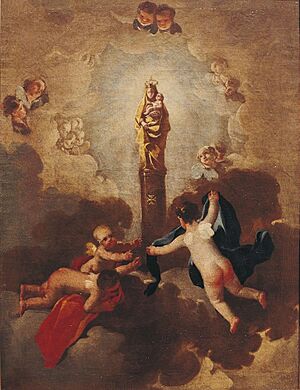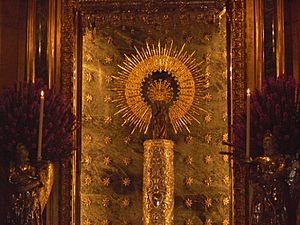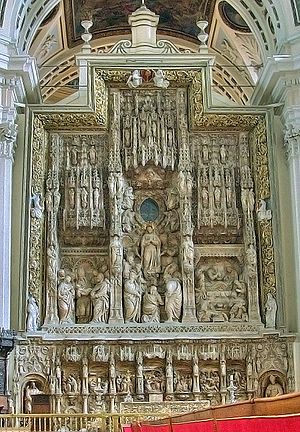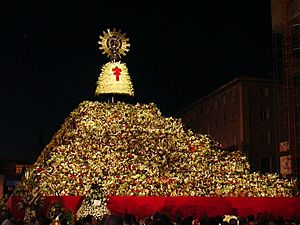Our Lady of the Pillar facts for kids
Quick facts for kids Our Lady of the Pillar |
|
|---|---|
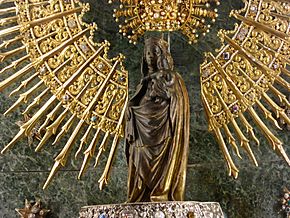
The image of Our Lady of the Pilar wearing her canonical crown
|
|
| Location | Zaragoza, Spain |
| Date | 12 October AD 40 (traditional) |
| Witness | Apostle James the Greater |
| Type | Marian Apparition |
| Approval | Pope Callixtus III (1456) Pope Innocent XIII (1723) Pope Pius X (1905) |
| Shrine | Basilica of Our Lady of the Pilar, Zaragoza, Spain |
| Patronage | Zaragoza, Spain, Melo, Uruguay, Buenos Aires, Argentina, Diocese of Imus, Cavite, Zamboanga City, Santa Cruz, Manila, Alaminos, Laguna, San Simon, Pampanga, Libmanan, Camarines Sur, Pilar and Morong in Bataan, Mamburao, Occidental Mindoro, Sibonga, Cebu, Baleno, Masbate, Cauayan, Isabela. |
| Attributes | The Blessed Virgin Mary carrying the Child Jesus atop a Pillar, surrounded by two or more angels |
Our Lady of the Pillar (Spanish: Nuestra Señora del Pilar) is a special title for the Blessed Virgin Mary. It comes from a traditional belief that Mary appeared to Apostle James in AD 40. This happened while he was preaching in what is now Spain.
People who believe this say it's the only time Mary showed a mystical power called bilocation. This means being in two places at once. She was still alive in Jerusalem but appeared in Spain. For Catholics, this is also seen as the first Marian apparition, which is a reported appearance of Mary.
This title is also linked to a wooden statue. It remembers the special appearance and is kept in the Cathedral-Basilica of Our Lady of the Pillar in Zaragoza, Spain. Popes have recognized this site. Pope Callixtus III offered special blessings to visitors in 1456. Later, Pope Innocent XIII asked people throughout the Spanish Empire to honor her in 1730. In 1905, Pope Pius X gave the statue a special honor called a canonical coronation.
Our Lady of the Pillar is the patroness (a special protector) of Aragon and its capital, Zaragoza. She is also the patroness of the Spanish Civil Guard. Her feast day is 12 October. This day is also Columbus Day and a national holiday in Spain.
Contents
History of Our Lady of the Pillar
The Early Story of the Apparition
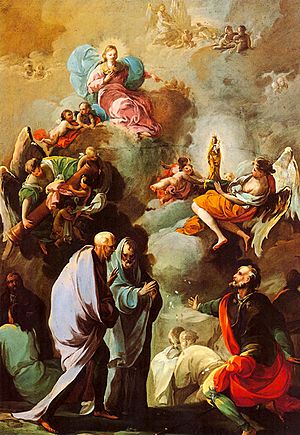
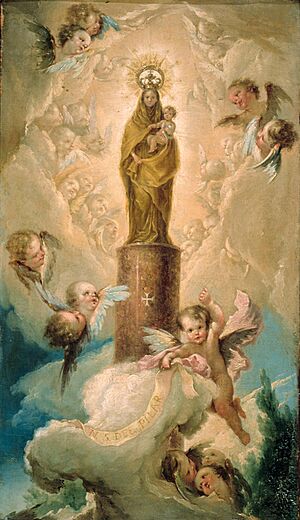
Catholic tradition says that early Christians, like the Apostles of Jesus, spread the message of Jesus. James the Greater traveled to Roman Hispania (modern-day Spain) to share the Gospel. He faced many challenges and felt discouraged.
In AD 40, while James was praying by the Ebro River in Zaragoza, something amazing happened. Mary, who was still alive in Jerusalem, appeared to him. She was surrounded by thousands of angels. She came to comfort and encourage him.
Old Records and Beliefs
Some of the oldest signs of devotion to Mary in Zaragoza are from Roman times. Christian tombs from that era show images that might represent Mary going to heaven. By the 4th century, people were placing special images on columns or pillars.
The first written record of devotion to Mary in Zaragoza is from 1155. By the 13th century, many pilgrims visited the site. The name Santa María del Pilar was first used in 1299. The idea that the first church was built by James in AD 40 was first recorded in 1318.
Church Approval and Growth
In 1296, Pope Boniface VIII offered special blessings to pilgrims visiting the shrine. In 1456, Pope Callixtus III officially encouraged pilgrimages to Our Lady of the Pillar. He also confirmed the name and its miraculous origin.
The feast day on 12 October became official in 1640. A writer named María de Ágreda (who died in 1665) wrote that Mary was carried from Jerusalem to Spain on a cloud by angels. She said the angels also built a marble pillar and placed a small image of Mary with the Child Jesus on it.
Official Acceptance of the Apparition
The Marian apparition of Our Lady of the Pillar was officially accepted by Pope Innocent XIII in 1723. There had been some questions about the church's miraculous beginning. Spain asked Pope Innocent XIII to help settle the matter.
After a careful study, the Church leaders approved the story. This story was then included in the special prayers for the feast of Our Lady of the Pillar on 12 October.
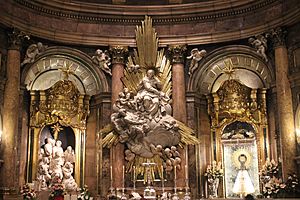
The story says that James the Greater was in Spain. One night, while praying by the Ebro River, Mary appeared to him. She was still alive at the time. She told him to build a small chapel there. James and his followers quickly built it. Over time, a larger church was built on that spot.
James later returned to Jerusalem and became a martyr (someone who dies for their faith) in AD 44. His followers are said to have brought his body back to Spain. The AD 40 apparition is the earliest recognized Marian apparition in the Catholic Church. It is special because Mary was still alive on Earth when it happened.
Pope Clement XII allowed the celebration of Our Lady of the Pillar throughout the Spanish Empire in 1730. Since 12 October is also the day Christopher Columbus first sighted land in the Americas in 1492, Mary became known as the Patroness of the Hispanic World under this title.
The Image of Our Lady of the Pillar
The Statue in Zaragoza
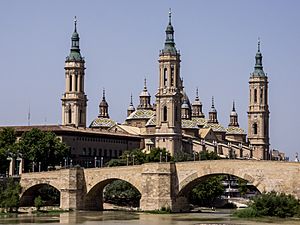
A fire in 1434 destroyed the church that stood before the current basilica. The building of the current Basilica of Our Lady of the Pillar in Zaragoza began in 1681 and finished in 1711.
The wooden statue of the Blessed Virgin Mary is in a style called Late Gothic. It is about 39 centimeters (15 inches) tall. It stands on a jasper pillar that is about 1.8 meters (5.9 feet) tall.
The statue shows Mary holding the Child Jesus on her left arm. The Child Jesus has a dove sitting on his left hand. Some records say an earlier wooden image was lost in the 1434 fire. This means the current statue might have been made by Juan de la Huerta or his students.
Some people believe the statue itself was made by angels. They think the angels sculpted it when they brought Mary from Jerusalem to Zaragoza. However, this idea is not officially recognized by the Church.
Since the 16th century, the pillar is usually covered with a skirt-like cloth called a manto (mantle). The whole statue and pillar are protected by a bronze case, and then another silver case. In 1905, during the time of Pope Pius X, the image was given a Canonical Coronation. This means it received a special crown.
Other Artworks
Our Lady of the Pillar is a common subject in Spanish art. Many paintings and sculptures of Mary and the Child Jesus show this theme. These artworks became very popular after the feast day was introduced across the Spanish Empire in 1730.
-
Statue of Our Lady of the Pillar by Cosme Damián Bas (around 1570), part of the main altarpiece of Albarracín Cathedral
-
Statue of Our Lady of the Pillar, part of the main altarpiece of the Basílica Nuestra Señora del Pilar in Buenos Aires (1732)
-
The shrine of Our Lady of the Pillar in Fort Pilar Zamboanga City, Philippines (1734).
-
Sculpture of Our Lady of the Pillar (1752) above the entrance to the Hospital de Pobres y Peregrinos in Tui, Pontevedra
-
St. James and his disciples adoring Our Lady of the Pillar, painting by Francisco de Goya (around 1775–1780).
-
Relief of Our Lady of the Pillar on the monument to Christopher Columbus in Columbus Square (Madrid, Spain), finished in 1885.
Feast Day Celebrations
The feast of Our Lady of the Pillar is celebrated on 12 October. She is the Patroness of Hispanic peoples and the Spanish Civil Guard. A large nine-day festival called Fiestas del Pilar takes place in Zaragoza every year to honor her.
These modern festivals start the weekend before 12 October and end the Sunday after. They were declared a "national holiday of touristic interest" in 1980.
The date 12 October is also important because it's the day Christopher Columbus first saw land in the Americas in 1492. Because of this, the feast day is also connected to Spain's national holiday. Since 1987, the official name of the national holiday is Día de la Fiesta Nacional de España.
Honoring Our Lady of the Pillar Around the World
Pilar, a shorter version of Maria del Pilar, is a common Spanish name. People named Pilar often celebrate their name day on the feast of Our Lady of the Pillar.
South America
- Cathedral of Our Lady of the Pillar and St. Raphael in Melo, Uruguay
- Nuestra Señora del Pilar, Recoleta neighborhood, Buenos Aires, Argentina
- Nuestra Señora del Pilar, Pilar, Buenos Aires Province, Argentina
- Cathedral of Our Lady of the Pillar, São João del-Rei, Brazil
Philippines
In the Philippines, which was ruled by Spain for over 300 years, Our Lady of the Pillar is honored as the patroness of many parishes and towns. Seven towns are even named Pilar after her. These towns are in the provinces of Abra, Bataan, Bohol, Capiz, Cebu, Surigao del Norte, and Sorsogon. Just like in Spain, her feast day is celebrated every 12 October.
- In Zamboanga City, the Virgin of the Pillar has been honored for almost 400 years. She is the patroness of the city and the Archdiocese of Zamboanga. A bas relief (a type of sculpture) of her is on the eastern gate of the 17th-century Spanish military fort called Fort Pilar. This fort is now a Catholic Marian shrine. The city also has a street named Pilar Street.
- In Davao City, a shrine for Nuestra Señora del Pilar was built in Magsaysay Park. This was done by a group of people from Zamboanga City living in Davao.
- Our Lady of the Pillar is also the patroness of Santa Cruz parish church in Manila. The Jesuits brought this devotion when they managed the church during the Spanish era. Her feast day is also 12 October in this district. The image was given a special crown on 7 December 2017.
- Our Lady of the Pillar is the patroness of Imus, Cavite and the Diocese of Imus. Her image is in the Imus Cathedral in Cavite. The city celebrates its fiesta every October with the Karakol, a special dance-procession. The image was given a special crown on 3 December 2012.
- Our Lady of the Pillar is also the patroness, with 12 October as the feast day, in the following places:
- City of Cauayan, Isabela.
- Town of Morong, Bataan.
- Don Rufino Alonzo Sr. Street Cotabato City Maguindanao.
- Town of Baleno, Masbate.
- Town of Pilar, Bataan.
- Town of Pilar, Bohol.
- Town of Pilar, Capiz
- Town of Pilar, Sorsogon.
- Town of San Simon, Pampanga.
- Town of Sibonga, Cebu.
- Town of Alaminos, Laguna.
- Town of Mamburao, Occidental Mindoro.
- Town & Diocese of Libmanan, Camarines Sur
- Brgy. Kalubkob, Silang, Cavite
- Brgy. Guinsay, Danao City, Cebu
- Brgy. New Guinlo, Taytay, Palawan
- Brgy. Del Pilar, Zaragoza, Nueva Ecija
- Brgy. Lumbangan, Nasugbu, Batangas
- Brgy. Indangan, Makilala, Cotabato
- Brgy. Maao, Bago, Negros Occidental
See also
In Spanish: Virgen del Pilar para niños


